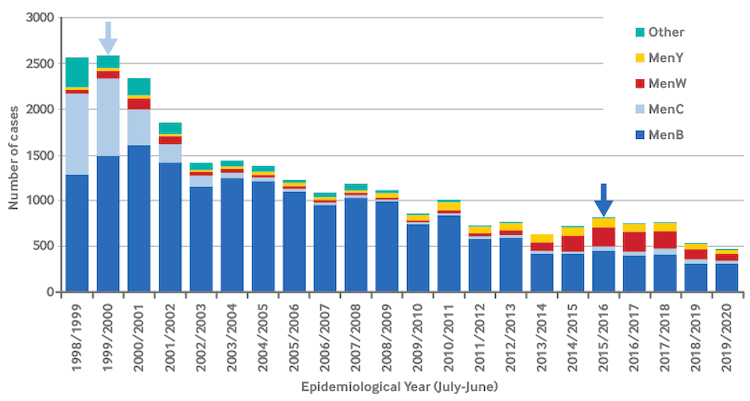The incidence of bacterial meningitis in Europe and the US is estimated at 0.7 to 0.9 in 100,000 people per year and has decreased by 3% to 4% in the past 10 to 20 years.[5]Brouwer MC, van de Beek D. Epidemiology of community-acquired bacterial meningitis. Curr Opin Infect Dis. 2018 Feb;31(1):78-84.
http://www.ncbi.nlm.nih.gov/pubmed/29176349?tool=bestpractice.com
The incidence in African countries is 10 to 40 in 100,000 people per year, reflecting the high rates of disease seen in epidemics of meningococcal meningitis occurring throughout the African meningitis belt during the dry season.[5]Brouwer MC, van de Beek D. Epidemiology of community-acquired bacterial meningitis. Curr Opin Infect Dis. 2018 Feb;31(1):78-84.
http://www.ncbi.nlm.nih.gov/pubmed/29176349?tool=bestpractice.com
[6]Paireau J, Chen A, Broutin H, et al. Seasonal dynamics of bacterial meningitis: a time-series analysis. Lancet Glob Health. 2016 Jun;4(6):e370-7.
https://www.thelancet.com/journals/langlo/article/PIIS2214-109X(16)30064-X/fulltext
http://www.ncbi.nlm.nih.gov/pubmed/27198841?tool=bestpractice.com
[7]van Kessel F, van den Ende C, Oordt-Speets AM, et al. Outbreaks of meningococcal meningitis in non-African countries over the last 50 years: a systematic review. J Glob Health. 2019 Jun;9(1):010411.
https://jogh.org/documents/issue201901/jogh-09-010411.pdf
http://www.ncbi.nlm.nih.gov/pubmed/30937163?tool=bestpractice.com
Globally, of the top 10 countries with the greatest absolute number of meningitis deaths, four are located outside the African meningitis belt (India, Pakistan, Afghanistan, China).[8]GBD 2016 Meningitis Collaborators. Global, regional, and national burden of meningitis, 1990-2016: a systematic analysis for the Global Burden of Disease Study 2016. Lancet Neurol. 2018 Dec;17(12):1061-82.
https://www.ncbi.nlm.nih.gov/pmc/articles/PMC6234314
http://www.ncbi.nlm.nih.gov/pubmed/30507391?tool=bestpractice.com
The epidemiology of bacterial meningitis has changed due to widespread immunization programs, including the introduction of protein-polysaccharide conjugate vaccines. In countries with universal Haemophilus influenzae type b (Hib) immunization programs, the incidence of Hib meningitis has declined by 95% to 99%.[5]Brouwer MC, van de Beek D. Epidemiology of community-acquired bacterial meningitis. Curr Opin Infect Dis. 2018 Feb;31(1):78-84.
http://www.ncbi.nlm.nih.gov/pubmed/29176349?tool=bestpractice.com
[9]Sáez-Llorens X, McCracken GH Jr. Bacterial meningitis in children. Lancet. 2003 Jun 21;361(9375):2139-48.
http://www.ncbi.nlm.nih.gov/pubmed/12826449?tool=bestpractice.com
Pneumococcal meningitis
In the US, where the heptavalent pneumococcal vaccine was introduced in 2000, the overall rates of pneumococcal meningitis have declined significantly from 0.8 in 100,000 in 1997 to 0.3 in 100,000 in 2010. A further decline in pneumococcal meningitis, particularly in patients ages 2 years or less, was recorded subsequent to the introduction of the 10- and 13-valent vaccines in 2010.[10]Castelblanco RL, Lee M, Hasbun R. Epidemiology of bacterial meningitis in the USA from 1997 to 2010: a population-based observational study. Lancet Infect Dis. 2014 Sep;14(9):813-9.
http://www.ncbi.nlm.nih.gov/pubmed/25104307?tool=bestpractice.com
[11]Hsu HE, Shutt KA, Moore MR, et al. Effect of pneumococcal conjugate vaccine on pneumococcal meningitis. N Engl J Med. 2009 Jan 15;360(3):244-56.
https://www.nejm.org/doi/full/10.1056/NEJMoa0800836
http://www.ncbi.nlm.nih.gov/pubmed/19144940?tool=bestpractice.com
[12]Olarte L, Barson WJ, Barson RM, et al. Impact of the 13-valent pneumococcal conjugate vaccine on pneumococcal meningitis in US children. Clin Infect Dis. 2015 Sep 1;61(5):767-75.
https://academic.oup.com/cid/article/61/5/767/303936
http://www.ncbi.nlm.nih.gov/pubmed/25972022?tool=bestpractice.com
Meningococcal meningitis
Most outbreaks of Neisseria meningitidis meningitis outside Africa are caused by meningococcal serogroups B and C, with emergence of serogroup W135 since 2012.[7]van Kessel F, van den Ende C, Oordt-Speets AM, et al. Outbreaks of meningococcal meningitis in non-African countries over the last 50 years: a systematic review. J Glob Health. 2019 Jun;9(1):010411.
https://jogh.org/documents/issue201901/jogh-09-010411.pdf
http://www.ncbi.nlm.nih.gov/pubmed/30937163?tool=bestpractice.com
In Africa, serogroups A, C, and W account for substantial proportions of meningococcal disease.[13]Peterson ME, Li Y, Bita A, et al. Meningococcal serogroups and surveillance: a systematic review and survey. J Glob Health. 2019 Jun;9(1):010409.
https://jogh.org/documents/issue201901/jogh-09-010409.pdf
http://www.ncbi.nlm.nih.gov/pubmed/30603079?tool=bestpractice.com
Meningococcal vaccines are available for serogroups A, B, C, W, and Y.
In the US, the incidence of meningococcal meningitis decreased from 0.72 in 100,000 in 1997 to 0.12 in 100,000 in 2010.[10]Castelblanco RL, Lee M, Hasbun R. Epidemiology of bacterial meningitis in the USA from 1997 to 2010: a population-based observational study. Lancet Infect Dis. 2014 Sep;14(9):813-9.
http://www.ncbi.nlm.nih.gov/pubmed/25104307?tool=bestpractice.com
This decrease has been linked to the introduction of the quadrivalent meningococcal conjugate vaccine in 2005. A decrease in incidence was also witnessed in other countries with conjugated vaccine uptake. In the UK, serogroup C vaccination was implemented in 1998 and serogroup B vaccination in 2015.[14]Ladhani SN, Ramsay M, Borrow R, et al. Enter B and W: two new meningococcal vaccine programmes launched. Arch Dis Child. 2016 Jan;101(1):91-5.
https://adc.bmj.com/content/101/1/91.long
http://www.ncbi.nlm.nih.gov/pubmed/26672098?tool=bestpractice.com
Much of the beneficial effect of these vaccines was achieved by herd immunity.[15]Whittaker R, Dias JG, Ramliden M, et al. The epidemiology of invasive meningococcal disease in EU/EEA countries, 2004-2014. Vaccine. 2017 Apr 11;35(16):2034-41.
https://www.sciencedirect.com/science/article/pii/S0264410X17303134?via%3Dihub
http://www.ncbi.nlm.nih.gov/pubmed/28314560?tool=bestpractice.com
[Figure caption and citation for the preceding image starts]: Laboratory-confirmed cases of invasive meningococcal disease in England by capsular group and epidemiologic year. The light blue and dark blue arrows denote the start of the national immunization programme against group C meningococcal (MenC) disease and group B meningococcal (MenB) disease, respectivelyPublic Health England [Citation ends].
